William Butterfield
William Butterfield (7 September 1814 – 23 February 1900) was a Gothic Revival architect and associated with the Oxford Movement (or Tractarian Movement). He is noted for his use of polychromy.
William Butterfield | |
|---|---|
 | |
| Born | 7 September 1814 |
| Died | 23 February 1900 (aged 85) |
| Nationality | British |
| Occupation | Architect |
| Awards | Royal Gold Medal (1884) |
| Buildings | St Ninian's Cathedral, Perth in Scotland, St Paul's Cathedral, Melbourne in Australia |
| Projects | Keble College, Oxford |
Biography
William Butterfield was born in London in 1814. His parents were strict non-conformists who ran a chemist's shop in the Strand. He was one of nine children and was educated at a local school. At the age of 16, he was apprenticed to Thomas Arber, a builder in Pimlico, who later became bankrupt. He studied architecture under E. L. Blackburne (1833–1836). From 1838 to 1839, he was an assistant to Harvey Eginton, an architect in Worcester, where he became articled. He established his own architectural practice at Lincoln's Inn Fields in 1840.
From 1842 Butterfield was involved with the Cambridge Camden Society, later The Ecclesiological Society. He contributed designs to the Society's journal, The Ecclesiologist. His involvement influenced his architectural style. He also drew religious inspiration from the Oxford Movement and as such, he was very high church despite his non-conformist upbringing. He was a Gothic revival architect, and as such he reinterpreted the original Gothic style in Victorian terms. Many of his buildings were for religious use, although he also designed for colleges and schools.
Butterfield's church of All Saints, Margaret Street, London, was, in the view of Henry-Russell Hitchcock, the building that initiated the High Victorian Gothic era. It was designed in 1850, completed externally by 1853 and consecrated in 1859.[1] Flanked by a clergy house and school, it was intended as a "model" church by its sponsors, the Ecclesiological Society. The church was built of red-brick, a material long out of use in London, patterned with bands of black brick, the first use of polychrome brick in the city, with bands of stone on the spire. The interior was even more richly decorated, with marble and tile marquetry.[1]
In 1849, just before Butterfield designed the church, John Ruskin had published his Seven Lamps of Architecture, in which he had urged the study of Italian Gothic and the use of polychromy. Many contemporaries perceived All Saints' as Italian in character, though in fact it combines fourteenth century English details, with a German-style spire.[1]
Also in 1850 he designed, without polychromy, St Matthias' in Stoke Newington, with a bold gable-roofed tower. At St Bartholomew's, Yealmpton in the same year, Butterfield used a considerable amount of marquetry work for the interior, and built striped piers, using two colours of marble.[1]

At Oxford, Butterfield designed Keble College, in a style radically divergent from the University's existing traditions of Gothic architecture, its walls boldly striped with various colours of brick. Intended for clerical students, it was largely built in 1868–70, on a fairly domestic scale, with a more monumental chapel of 1873–6. In his buildings of 1868–72 at Rugby School, the polychromy is even more brash.[2]
Butterfield received the RIBA Gold Medal in 1884. He died in London in 1900, and was buried in a simple Gothic tomb in Tottenham Cemetery, Haringey, North London. The grave can be easily seen from the public path through the cemetery, close to the gate from Tottenham Churchyard. There is a blue plaque on his house in Bedford Square, London.
Works
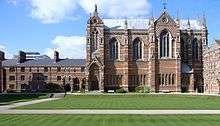
.jpg)
.jpg)
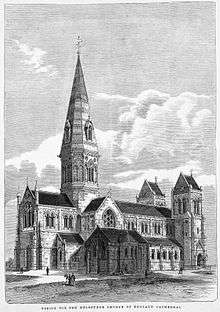


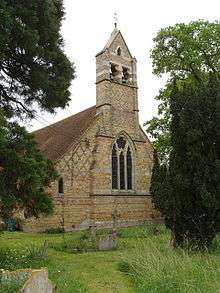
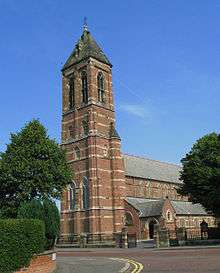

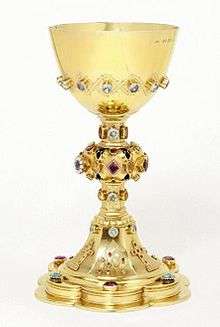
Butterfield's buildings include:
- 1842
- Highbury Congregational Chapel (Cotham Church), Bristol.[3]
- 1843
- St John's Church, Jedburgh's lychgate.[4]
- 1845
- St Saviour's Church and vicarage, Coalpit Heath, south Gloucestershire, 1845 (Butterfield's first Anglican work)[5]
- St Augustine's College, Canterbury, Kent, 1845[6]
- St John the Baptist parish church, Hellidon, Northamptonshire: restoration, 1845–47[7]
- 1846
- St Nicholas' Church, Thanington Without, Kent: restoration, 1846[6]
- St Nicholas' Church, Ash, Kent: restoration, 1846[6]
- Abbey Church of Saints Peter & Paul, Dorchester on Thames, Oxfordshire: restoration, 1846–53[8]
- 1847
- St Andrew's parish church, Ogbourne St Andrew, Wiltshire: restoration, 1847–49[9] and vicarage, 1848[10]
- Parish Church of the Holy Trinity with St Edmund, Horfield, Bristol, nave and aisles c1847
- 1849
- St Bartholomew's Church, Yealmpton, Devon, PL8 2HG, reconstruction 1849–1852
- The Cathedral of the Isles, Great Cumbrae, Scotland, started 1849 but still incomplete
- St Mary's Church, Ottery St Mary, Devon restoration 1849–1850[11]
- 1850
- Goldern Lion Hotel (1850) in the Norfolk sea-side town of Hunstanton.[12]
- St Mary Magdalene church, West Lavington, West Sussex, 1850
- St Ninian's Cathedral, Perth, Scotland, 1850
- St James & St Anne parish church and vicarage, Alfington, Devon, 1850
- Wantage Cemetery, Berkshire: chapel, 1850[13]
- 1851
- St Mary's Church, Emmorton, Maryland: stained glass windows, 1851
- St Martin's Church, Great Mongeham, Kent: restoration, 1851[6]
- 1853
- All Saints' Wykeham, Scarborough, 1853–1855[14]
- Milton Ernest Hall, Bedfordshire, 1853–1858
- St Mary's Church, Langley, Kent, 1853[6]
- St Mary and St Melor parish church, Amesbury, Wiltshire: restoration, 1853[15]
- 1854
- 1855
- St Mary's parish church, Marlston, Berkshire, 1855[17]
- All Saints' Church, Braishfield, Hampshire, 1855
- 1856
- St John the Evangelist's parish church, Milton, Oxfordshire, 1856[18]
- Balliol College, Oxford Chapel, 1856–57[19]
- 1857
- St Michael's parish church, Gare Hill (Gaer Hill), near Trudoxhill, Somerset, 1857
- St James' church, school and village buildings, Baldersby St James, North Yorkshire, 1857
- All Saints' parish, Charlton-All-Saints, Wiltshire: school, 1857–58[20]
- 1858
- St Andrew's parish church, Landford, Wiltshire, 1858[21]
- Church of St John the Evangelist, better known as the Afghan Church, Mumbai: the reredos, the Afghan War Memorial mosaics, and the tiles, pews and screen, 1858
- St John the Evangelist parish church, Hammersmith, 1858–59[22]
- St John the Baptist, Latton, Wiltshire: chancel, 1858–63[23]
- 1859
- All Saints, Margaret Street, London, 1859[24] ** St Mary the Virgin, Etal, Northumberland 1859[25]
- St Nicholas' school, Newbury, Berkshire, 1859[26]
- Standlynch Chapel Trafalgar House, Wiltshire: restoration of church, 1859–66[27]
- 1860
- 1861
- St John the Baptist church, Bamford, Hope Valley, Derbyshire: restoration, 1861
- St Michael's parish church, Letcombe Bassett, Berkshire (now Oxfordshire): nave and south aisle, 1861[29]
- St Mary the Virgin parish church, Castle Eaton, Wiltshire: restoration, 1861–63[30]
- 1862
- Lych gate at St Michael & All Angels' Churchyard extension, Houghton-le-Spring, Durham, 1862,[31]
- St Martin's parish church, Bremhill, Wiltshire: restoration, 1862–63[32]
- St Michael's parish church, Lyneham, Wiltshire: nave roof and chancel, 1862–65[33]
- 1863
- Church of St Cross, Manchester, Clayton, Manchester, 1863–66[34]
- St Margaret's parish church, Mapledurham, Oxfordshire: restoration, 1863[35]
- St Mary Magdalene church, Enfield Chase, Middlesex, 1883[36]
- St Michael's parish church, Aldbourne, Wiltshire: restoration, 1863–67[28]
- 1864
- St Sebastian, Heathland, Wokingham, Berkshire, 1864[37]
- Merton College, Oxford: Grove Building, 1864[38]
- St Andrew's parish church, Blunsdon St Andrew, Wiltshire: restoration: 1864–68[39]
- Christ Church, Emery Down, Hampshire, 1864[40]
- 1865
- St George's parish church, Wootton, Northamptonshire: restoration, 1865[41]
- St Lawrence's Church, Godmersham, Kent: restoration, 1865[6]
- St Augustine's, Queen's Gate, London, 1865
- St Augustine's parish church, Penarth, Glamorgan, 1865–66.
- SS. Peter & Paul parish church, Heytesbury, Wiltshire: restoration, 1865–67[42]
- Holy Saviour church,[43] Hitchin, Hertfordshire, 1865
- 1866
- St Anne's church, Dropmore, Littleworth, Buckinghamshire, 1866[44]
- All Saints' parish church, Rangemore, Staffordshire, 1866–67
- St Peter's parish church, Highway, Wiltshire, 1866–67[45]
- 1867
- St Barnabas' parish church, Horton-cum-Studley, Oxfordshire, 1867[46]
- St Mary's parish church, Beech Hill, Berkshire, 1867[47]
- Little Faringdon, Oxfordshire: Rectory, 1867[48]
- St Mary's parish, Lower Heyford, Oxfordshire: remodelling of Old Rectory, 1867 (now Tall Chimneys)[35]
- 1868
- The Royal Hampshire County Hospital, Winchester, Hampshire, 1868
- St Paul's Church, Wooburn, Buckinghamshire: alterations, 1869
- 1869
- St Alban's Church, Holborn, London, 1862
- St Mary Brookfield, Dartmouth Park Road, Tufnell Park, London NW5, 1869–75
- St Peter's Cathedral, Adelaide, South Australia, 1869–1902[49]
- 1870
- All Saints' parish church, Whiteparish, Wiltshire: restoration, 1870[50]
- St Leonard's parish church, Broad Blunsdon, Wiltshire: rebuilding, 1870[51]
- Church of St Peter, Great Berkhamsted, Hertfordshire: restoration, 1870–71[52]
- The Rectory (now Butterfield House), (formerly attached to Church of St Mary the Virgin, Baldock) Hitchin Street, Baldock, Hertfordshire, 1870–1873
- 1871
- St Margaret of Antioch, Barley, Hertfordshire, 1871 additions
- St Paul's, Covent Garden, London, 1871–2. Interior alterations.[53]
- 1872
- 1873
- St Michael and All Angels' parish church & school, Poulton, Gloucestershire, 1873[55]
- St Mary's parish church, Dinton, Wiltshire: restoration, 1873–75[56]
- St Peter's parish church, Clyffe Pypard, Wiltshire: restoration, 1873–75[56]
- 1874
- All Saints' parish church, Braunston, Northamptonshire: restoration, 1874[57]
- All Saints' church, Babbacombe, Devon 1874
- St Denis' church, East Hatley, Cambridgeshire: restoration, 1874[58]
- St George's parish church, West Harnham, Salisbury, Wiltshire: restoration, 1874[59]
- St George's Church, Morebath 1874–75
- St Mary's School, Wantage, Berkshire (now Oxfordshire), 1874–75[60]
- St Margaret's parish church, Knook, Wiltshire: restoration, 1874–76[61]
- 1875
- Rugby School, Warwickshire: Chapel and Quadrangle, 1875
- Shaw-cum-Donnington School, Shaw, Berkshire, 1875[62]
- All Hallows Church, Tottenham, London: restoration, 1875-1877
- 1876
- Keble College, Oxford 1876[63]
- St Andrew's Church, Buckland, Kent: restoration, 1876[6]
- Holy Cross parish church, Ashton Keynes, Wiltshire: restoration: 1876–77[64]
- St Catherine's parish church, Netherhampton, Wiltshire, 1876–77[65]
- 1877
- Ascot Priory, Ascot, Berkshire: chapel, 1877[66]
- St Andrew's parish church,[67] Rugby, Warwickshire, 1877 with later additions of 1895
- St James' church, Christleton, Cheshire, rebuilt 1877
- 1878
- Exeter School, Exeter, Devon, 1878–1880
- St Mary Magdalene parish church, Winterbourne Monkton, Wiltshire: rebuilding, 1878[68]
- St John the Baptist parish church, Foxham, Wiltshire: 1878–81[69]
- St John the Evangelist church,[70] Clevedon, Somerset, 1878
- St Mary's parish church, Donnington, Berkshire: chancel, 1878[71]
- St Mary's Convent, Wantage, Berkshire (now Oxfordshire): Noviciate, 1878[13]
- St Mary's parish church, Dodford, Northamptonshire: restoration, 1878–80[72]
- 1880
- St Columba's College Chapel, Whitechurch, County Dublin, Ireland, 1880
- St Edith of Wilton parish church, Baverstock Lane, Dinton, Wiltshire: restoration 1880–93[73]
- St Paul's Cathedral, Melbourne (except main tower and spire), Australia, 1880–1891
- 1881
- Sarum College, Salisbury, Wiltshire: chapel, 1881[74]
- 1885
- St John the Baptist's Church, Ault Hucknall Restoration 1885–89.
- 1888
- 1891
- St Mark's Church, Dundela, Belfast, Northern Ireland, 1878 with later additions of 1891
- 1895
- St Andrew's parish church,[67] Rugby, Warwickshire, 1877 with later additions of 1895
- awaiting date
- Ottery St Mary parish church, Devon: south transept refurbishment and marble font
- St Mawgan Old Rectory, Cornwall
- St Peter's Church, Bont Goch, Ceredigion[75]
References
- Hitchcock 1977, pages 247–8
- Hitchock 1977, page 264
- Historic England. "Cotham Church (1282286)". National Heritage List for England. Retrieved 19 May 2017.
- Stuff, Good. "Pleasance, St John's Episcopal Church with Lych Gate and Boundary Wall, Jedburgh, Scottish Borders". britishlistedbuildings.co.uk. Retrieved 14 December 2019.
- "Beginnings". Coalpit Heath: St Saviour's Church. August 2008. Retrieved 20 December 2016.
- Homan 1984, page 106
- Pevsner & Cherry, 1973, page 252
- Sherwood & Pevsner, 1974, page 579–583
- Pevsner & Cherry, 1975, page 365
- Pevsner & Cherry, 1975, page 366
- "Ottery St Mary". Exeter and Plymouth Gazette. Exeter. 30 March 1850. Retrieved 14 September 2015.
- "Golden Lion Hotel, Hunstanton, Norfolk". www.britishlistedbuildings.co.uk.
- Pevsner, 1966, page 253
- Rhea, Nicholas (1985). Portrait of the North Yorkshire Moors.
- Pevsner & Cherry, 1975, page 90
- Pevsner & Cherry, 1975, page 458
- Pevsner, 1966, page 177
- Sherwood & Pevsner, 1974, page705
- Sherwood & Pevsner, 1974, page 101
- Pevsner & Cherry, 1975, page 162
- Pevsner & Cherry, 1975, page 291
- "St John the Evangelist Churchyard". London Gardens Online. 1 November 2011. Retrieved 25 January 2015.
- Pevsner & Cherry, 1975, page 293
- "History & architecture". All Saints Margaret Street website. Retrieved 26 May 2012.
- Historic England. "Church of St. Mary the Virgin (1042179)". National Heritage List for England. Retrieved 18 November 2017.
- Pevsner, 1966, page 182
- Pevsner & Cherry, 1975, page 531
- Pevsner & Cherry, 1975, page 82
- Pevsner, 1966, page 166
- Pevsner & Cherry, 1975, page 160
- Lanagan, Paul. "Houghton-le-Spring: Hillside Cemetery Lych Gate Restoration". www.houghtonlespring.org.uk.
- Pevsner & Cherry, 1975, page 140
- Pevsner & Cherry, 1975, page 319
- The Buildings of England: Lancashire – Manchester and the South East, 2004
- Sherwood & Pevsner, 1974, page 693
- Heywood, Joy. "William Butterfield (1814–1900)". Enfield: Saint Mary Magdalene. Retrieved 20 December 2016.
- Pevsner, 1966, page 154
- Sherwood & Pevsner, 1974, page 164
- Pevsner & Cherry, 1975, page 118
- "Parishes: Lyndhurst | British History Online". British-history.ac.uk. 10 June 1908. Retrieved 5 November 2019.
- Pevsner & Cherry, 1973, page 470
- Pevsner & Cherry, 1975, page 266
- "Home". Holy Saviour Church Hitchin.
- Pevsner, 1960, page 112
- Pevsner & Cherry, 1975, page 268
- Sherwood & Pevsner, 1974, page 656
- Pevsner, 1966, page 84
- Sherwood & Pevsner, 1974, page 685
- Marsden, Susan, Paul Stark and Patricia Sumerling, Heritage of the City of Adelaide, Adelaide 1990, pp. 347-349
- Pevsner & Cherry, 1975, page 571
- Pevsner & Cherry, 1975, page 144
- Birtchnell, Percy (1960). A Short History of Berkhamsted. The Bookstack. p. 30. ISBN 978-1-871372-00-7.
- Sheppard, F.H.W., ed. (1970). "St. Paul's Church". Survey of London: volume 36: Covent Garden. pp. 98–128.
- Pevsner & Cherry, 1975, page 374
- Verey, 1970, pages 370–371
- Pevsner & Cherry, 1975, page 182
- Pevsner & Cherry, 1973, page 120
- "St Denis' East Hatley". Hatley. Retrieved 8 February 2020.
- Pevsner & Cherry, 1975, page 563
- Pevsner, 1966, page 254
- Pevsner & Cherry, 1975, page 283
- Pevsner, 1966, page 357
- Sherwood & Pevsner, 1974, pages 225–229
- Pevsner & Cherry, 1975, page 95
- Pevsner & Cherry, 1975, page 354
- Pevsner, 1966, page 68
- "St. Andrew's parish church, Rugby".
- Pevsner & Cherry, 1975, page 591
- Pevsner & Cherry, 1975, page 251
- "A Community of Faith". www.stjohnsclevedon.org.uk.
- Pevsner, 1966, page 213
- Pevsner & Cherry, 1973, page 188
- Pevsner & Cherry, 1975, page 105
- Pevsner & Cherry, 1975, page 427
- "Church of St Peter, Ceulanamaesmawr, Ceredigion". www.britishlistedbuildings.co.uk.
Bibliography
- Hitchcock, Henry Russell (1977). Architecture:Nineteenth and Twentieth Centuries. Pelican History of Art. Harmondsworth: Penguin Books. ISBN 978-0-14-056115-9.
- Homan, Roger (1984). The Victorian Churches of Kent. Chichester: Phillimore & Co. Ltd. ISBN 978-0-85033-466-1.
- Tyack, Geoffrey; Bradley, Simon & Pevsner, Nikolaus (2010). The Buildings of England: Berkshire. New Haven and London: Yale University Press. p. 800. ISBN 978-0-300-12662-4.
- Pevsner, Nikolaus; Williamson, Elizabeth (1994). The Buildings of England: Buckinghamshire. New Haven and London: Yale University Press. p. 832. ISBN 978-0-300-09584-5.
- Pevsner, Nikolaus; Cherry, Bridget (1973) [1961]. The Buildings of England: Northamptonshire. New Haven and London: Yale University Press. p. 520. ISBN 978-0-300-09632-3.
- Pevsner, Nikolaus; Cherry, Bridget (1975) [1963]. The Buildings of England: Wiltshire. New Haven and London: Yale University Press. p. 664. ISBN 978-0-300-09659-0.
- Sherwood, Jennifer; Pevsner, Nikolaus (1974). The Buildings of England: Oxfordshire. New Haven and London: Yale University Press. p. 948. ISBN 978-0-300-09639-2.
- Verey, David; Brooks, Alan (1999). The Buildings of England: Gloucestershire: The Cotswolds. New Haven and London: Yale University Press. p. 832. ISBN 978-0-300-09604-0.
External links
| Wikimedia Commons has media related to William Butterfield. |
| Wikisource has the text of the 1911 Encyclopædia Britannica article Butterfield, William. |
